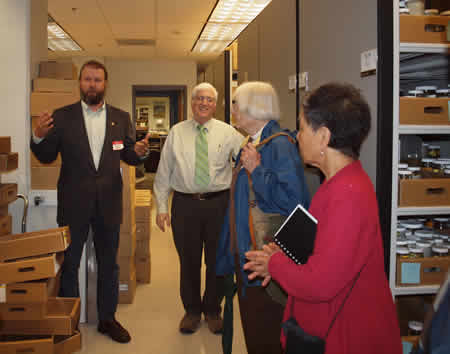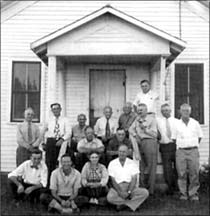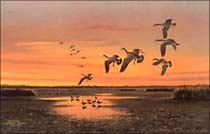CNRA: A Brief History
CNRA was founded in 1951 by a small group of citizens concerned about cutting an alley of large hackberry trees during construction of Highway 30 near Oconomowoc. The organization was to be militant in nature, follow the principles of Aldo Leopold, and remain a group of committed conservationists. Its early actions led to designation of the state’s first wilderness area located in the Flambeau State Forest bordering the Flambeau River. Throughout the 1950s its natural roadside vegetative policy served as a guide to highway crews and utilities in their removal of roadside vegetation. Many of Wisconsin’s first conservation laws were shaped by CNRA.
DDT, Wisconsin’s Waterways, Natural Roadsides In the late sixties CNRA brought the Environmental Defense Fund to Wisconsin to fight the neurotoxin DDT. Worldwide expert testimony at a DNR hearing resulted in the declaration of DDT as a pollutant of the state’s waters. Subsequently DDT was banned in Wisconsin and two years later in the U.S. A campaign by CNRA to clean up the Wisconsin River in the 1970s and a special report, Stream of a Thousand Isles: The Wisconsin River, Its History and a Plan for Restoration, were invaluable in spreading the word on the effects of pollution in our waterways. Similar efforts by CNRA related to wetland preservation in the 1980s led to stronger state wetland protection laws. CNRA participated in the successful 40-year fight to protect the Kickapoo River from a dam and speculative development, which threatened an area rich in archeological history and scenic beauty. A 50-year campaign by CNRA for improved roadside management has contributed to reduced mowing, limited herbicide use and increased native vegetation along Wisconsin’s highways.
Horicon Marsh Horicon Marsh has been a special place for CNRA. In 1951 CNRA supported legal action by its president against the Fish and Wildlife Service to exclude hunting on the refuge. Twenty-five years later, in 1976 during the “Goose Wars,” the organization itself sued the managing agencies to prevent dewatering of the marsh. To fight dewatering it established the Horicon Defense Fund derived from sale of Owen Gromme’s print: Requiem Horicon Marsh: 1916-1976. While both suits lost, eventually policies changed to favor CNRA’s positions. Over the years the Horicon Defense Fund has continued to support marsh research, the Marsh Haven Nature Center, and numerous partnerships of agencies. The Fish and Wildlife Service placed CNRA’s publication, CNRA: The First 50 Years, 1951-2001, in its 100-year time capsule buried at Horicon headquarters. In recent years CNRA has joined the fight to protect wildlife and scenic beauty of the marsh from giant wind turbines planned and constructed on its periphery.
CNRA Today Time has changed CNRA. The ecological values once limited to a few individuals and organizations are now widely prevalent. Many different environmental groups are now prepared to act in crisis situations. While CNRA’s mission and organizational structure remain the same as it was almost 60 years ago, its activities today are linked closely to local issues and supporting other conservation organizations.
CNRA Members remembered
Roy Lukes, CNRA Member, (1929 - 2016)
Naturalist, Teacher, Author, Roy earned a Bachelor’s degree at the State Teacher’s College in Oshkosh (UW-Oshkosh) and Master’s degree in Education in Madison. He taught science in various Wisconsin schools eventually settling in Door County. Roy started as a naturalist at The Ridges Sanctuary in 1964 and helped popularize the nature preserve through his guided tours. He other contributions include extending the trail system, leading early morning bird hikes, creating educational programs, and a quarterly newsletter. Lukes wrote more than 3,000 nature columns and illustrated them with his own photography. His columns appeared in Green Bay Press-Gazette, Appleton Post Crescent, and many other Door County publications. Roy received an honorary Doctor of Science degree from Lawrence University, the UW-Oshkosh Chancellor’s Medallion, and UW-Oshkosh 50th alumni anniversary award. Lifetime Achievement Awards were presented from the Gathering Waters Conservancy and the Wisconsin Society for Ornithology. He received many other literary, environmental, and civic awards over his lifetime.
Olive Thomson, CNRA Advisor and Silver Acorn recipient, (1916 - 2016)
Olive studied at UW-Madison with famed botanist Norman C. Fassett and worked in the Herbarium. In 1976 she revised and updated Fassesett's Spring Flora of Wisconsin by adding keys and descriptions. Olive was a dedicated botanist and conservationist who was among the first in the state to work on a prairie restoration. Olive conceived the idea for a Prairie Heritage Trail alsong County Highway JG south of Mount Horeb, WI. The trail was dedicated by Dane County for protection and received a National Bicentennial Award. She and her husband, Professor John Thomson, partnered with the Nature Conservancy to create the Thomson Memorial Prairie in honor of their son Douglas. The land encompasses 323 acres of remnant dry prairie near Mount Horeb, WI. They were joint recipients of the Gulf Oil Conservation Award.
Orie Louck, CNRA member, (1931 - 2016)
Orie was a CNRA member for over 50 years. He earned his BS and MS at the University of Toronto and a PhD in Plant Ecology at UW-Madison. He joined the Botany Department in 1962 and achieved the rank of professor in 1967. He later joined the faculty of Miami University in Ohio until his retirement. He is remembered for his tireless efforts to solve ecological problems such as habitat destruction, deforestation, acid rain, and climate change. Among his many acheivements were his testimony in1969 that led to the banning of DDT in Wisconsin, negotiation of the 1972 and1978 Great Lakes Water Quality Agreements, and exposing destructive coal mining practices in the Appalachian Mountains.
George Becker, biology professor and ichthyologist at the University of Wisconsin-Stevens Point and author of "Fishes of Wisconsin".
George served as CNRA president, 1972 to 1974 and together with other concerned CNRA members formed the Wisconsin Rive Restoration committee to inform the public on pollution and other issues concerning the Wisconsin River. With funds from CNRA, the Wisconsin River Restoration Committee published the special report "Stream of a Thousand Isles: The Wisconsin River: Its History and a Plan for Restoration". George was awarded CNRA's Silver Acorn Award in 1973.
See the link to Fish Man of Wisconsin for an engaging story about George and his passion.
 Justin Sipiorski, Director Lecturer in Ichthyology and Curator of Fishes at UW Stevens Point leads a CNRA tour of the Fish Collection and expounds on the important research being conducted by faculty and students.
Justin Sipiorski, Director Lecturer in Ichthyology and Curator of Fishes at UW Stevens Point leads a CNRA tour of the Fish Collection and expounds on the important research being conducted by faculty and students.
Emily Earley, program coordinator and publication editor for UW Madison's Institute for Environmental Sudies for 15 years.
Emily is a longtime CNRA member and active in numerous conservation groups
including The Nature Conservancy, The Sigurd Olson Institute, and 1000 Friends of Wisconsin.
Ruth Hine, zoologist and chief of Research Information and Publications Section the WI DNR's Bureau of Research for over four decades. CNRA member and advisor, Ruth Hine received the CNRA Silver Acorn Award in 1974. Ruth authored articles and reports with CNRA who's purpose was to educate the public on conservation issues. She was instrumental in the development of Wisconsin's endangered species program.
Cyril Kabat, DNR director of natural resources research, Cy brought professional expertise to our discussions and publications. He encouraged CNRA to publish the booklet Managing Wisconsin's Roadsides. Cy held a strong commitment for conservation issues until his passing June 2010.
Janice Striefel, writer, naturalist, photographer and entomologist, WildOnes published a compilation of her The Inside Story articles with a contribution from CNRA. The articles were filled with scientific facts, legend and lore and are an educational treasure about native plants and biodiversity.
Dr. John W. Thomson, CNRA Advisor John Thomson, Click for webpage John Walter Thomson and "Remembering a Conservation Leader and Educator" by
Ethel Princl, Ethel Princl was CNRA treasurer from 1970 to 1991. Because she was in poor health she turned the books over to Charles M. Sturm who has his own accounting firm and volunteers his time to CNRA. Ethel spent her last years in a Wausau nursing home and at age 95 was still requesting minutes and treasurer's reports from CNRA meetings. Read Ethel's article about her activities as CNRA treasurer in CNRA's 50th Anniversary booklet. pg 100. People Places Things
Carla Ochser Kruse, Longtime CNRA member passed away on September 24, 2009 at the age of 78. Carla was one of CNRA's first members. She and Harold became engaged at CNRA's Annual Meeting in 1950. Carla was a signer of the DDT petition and for her entire life worked against chemicals in the environment. She and Harold operated an organic farm near Loganville. They were awarded Silver Acorns in 1965. Carla was CNRA secretart and editor for many years .Since springtime meant that the garden could be planted, the songbirds returned, and the woodland flowers would bloom, it was Carla’s favorite time of year.
Photos: The Flambeau River
State Forest, Sandhill cranes,
Kickapoo River bluffs
.


